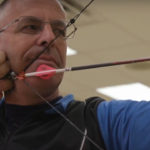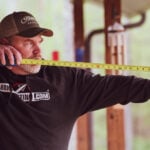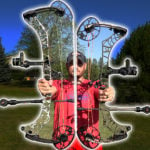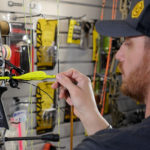Without a doubt, every bowhunter wants to improve their performance as an archer. However, the technical aspects of archery can be intimidating for hunters who may have picked up the sport as a way to spend more time in the woods each fall.
On the other hand, some skilled bowhunters make it seem like they could disassemble and rebuild their bows in their sleep.
Technical knowledge can improve your performance and confidence in your equipment, however, the foundation for success in archery is the ability to control the physical and mental aspects of the sport.
The good news is that regardless of your experience level, access to equipment, or bow tinkering knowledge there are some practical and accessible steps that any bowhunter can take to improve their performance.
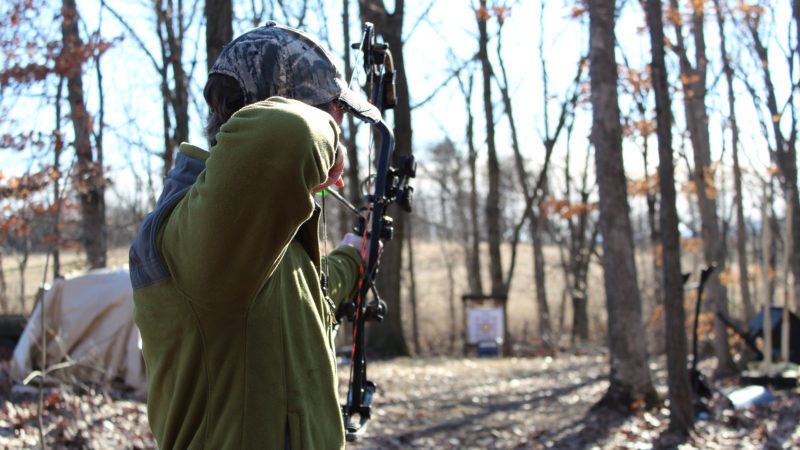
1. Try a Tension-Activated or Hinge Release
Adding a tension-activated or hinge style release to your offseason shooting regimen can be an extremely effective way to increase your accuracy over time. Both of these tools are designed to provide a surprise release in order to train the archer to focus on form and pin position rather than anticipating the shot.
A hinge style release is fired by squeezing your shoulder blades together while relaxing your wrist, which rotates the release and activates the shot.
A tension- activated release is set to 5-7 pounds above your draw weight and fires when enough pressure is applied to the release by pulling through the shot.
Back tension and hinge releases can be especially effective with hunters who deal with bouts of target panic. As someone who has suffered through his fair share of target panic I can attest that practicing with a hinge or tension-activated release can greatly reduce trigger punching and other symptoms of target panic.
While it’s not a panacea for target panic or other shooting woes, removing the physical action of pulling a trigger allows shooters to build consistency with form and follow through.
Even archers who are not suffering from target panic and are looking for ways to improve their consistency, can benefit from interspersing hinge and back tension releases into their shooting routines.
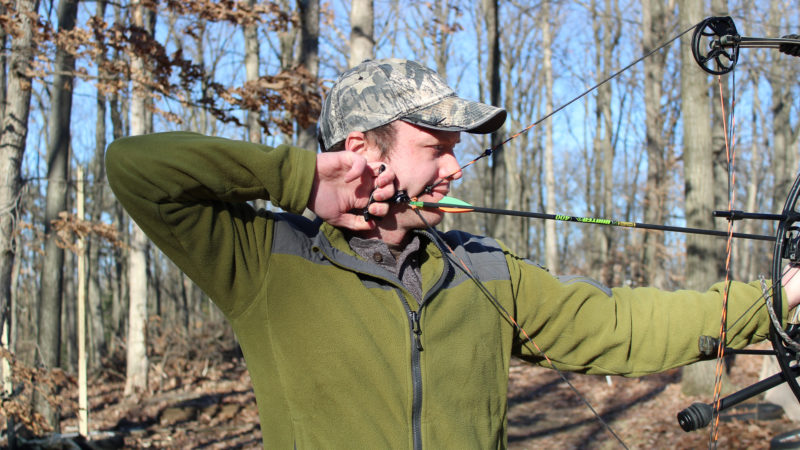
2. Blind Bale Shooting
When it comes to consistent shooting form, muscle memory is the name of the game, and few exercises build muscle memory better than blind bale shooting. Another positive about blind bale shooting is that you probably already have everything you need for this exercise.
No bow press or fancy releases needed, just a target and 10 feet of backyard or basement space. This exercise is often done at a distance of less than 10 feet and with the shooter’s eyes closed in order to concentrate on form, rather than impact.
When blind bale shooting I often talk myself through the physical process of shooting my bow; drawing, anchoring, hand position, pin hold, and back tension, until I fire a shot.
This exercise is a great way to break back into a shooting routine after a long layoff or as a way to mitigate any target panic that may creep in from time to time.
Like shooting with a hinge or back tension release for the first time, blind bale shooting may feel a little awkward at first but it can be one of the best exercises to restore consistent archery form.
3. Stabilize Your Muscles
The sport of archery doesn’t require hulking muscles or extreme flexibility. However, it can be worthwhile to incorporate a few exercises for the sake of injury prevention and increased performance.
When exercising, form and technique should always trump weight, so be cautious if it has been a while since your last workout. If you do not have access to equipment, consider using exercise bands or alternative weighted objects such as a jug of water or sand to get started.
A simple single arm dumbbell row is a great way to emphasize and strengthen your pull motion. Place your hand and one knee on a bench while keeping your back flat and parallel to the ground. Grab a weight with your free hand and pull to your ribs. 8-12 repetitions for 2-3 sets is a great place to start.
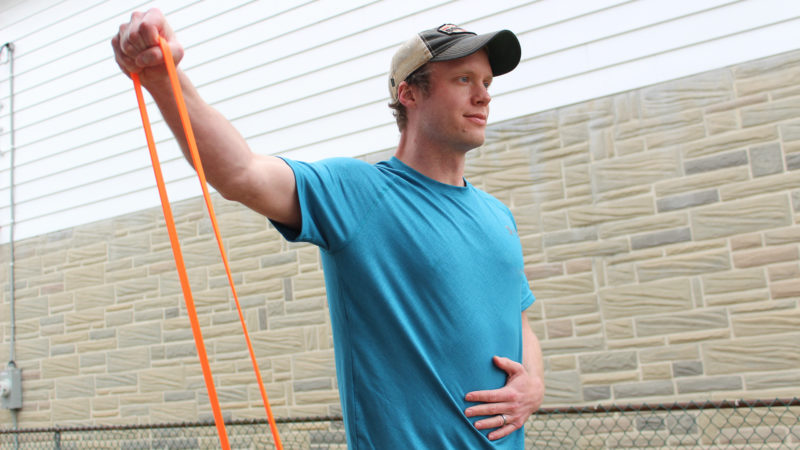
To help increase shoulder stabilization, a simple lateral dumbbell raise can be effective. Standing with your knees slightly bent and a weight in one or each hand at your side, lift the weight while maintaining a slight bend in the elbows and a straight back.
Repeat 8-12 times in 2-3 sets with a break between each set. Aside from these few exercises, be sure to do some basic stretching and incorporate additional exercises that may meet your individual needs.
4. Live Practice
To be a consistently successful bowhunter you have to be comfortable shooting animals with your bow. That may be the most obvious sentence that you read in a while, but building a background of real world big game shot experiences takes years to develop.
Taking advantage of lower stress, offseason opportunities such as chasing groundhogs with your bow or flinging a few arrows at rabbits or squirrels, can increase the confidence you have in your shot performance when it matters most.
Obviously, shooting at a groundhog is not the same as sending an arrow at a deer. However, holding a pin on a live animal that can jump the string or change positions can help you prepare for scenarios you may face in the deer or turkey woods with your bow. If nothing else, you will have a blast chasing new critters with your bow.
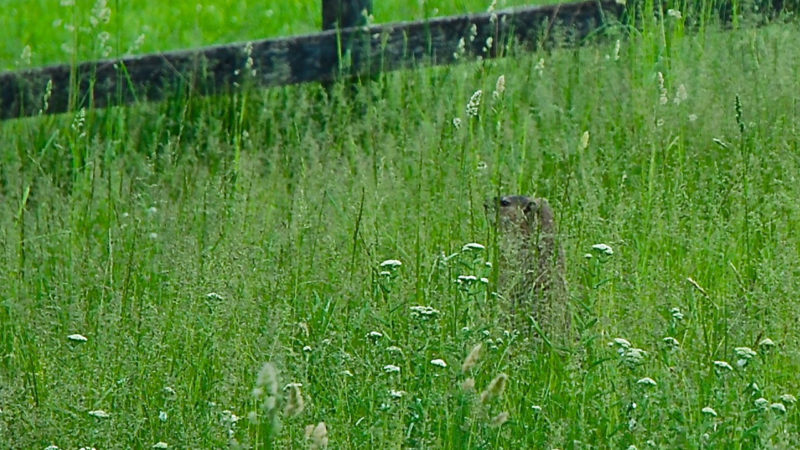
5. Find an Expert
If you are not an archer with a lot of technical knowledge, find someone who is knowledgeable. In today’s digital world it is easier than ever to access knowledge or connect with experts.
There are many informational and tutorial YouTube channels that can help improve your technical knowledge of the sport, or give you additional exercises to complete to improve your performance.
Additionally, your local archery shop may offer opportunities to be coached by an expert. Even a few sessions can be beneficial.
When you are shopping, or otherwise spending time in your local pro shop, don’t be afraid to ask questions. In most cases, the workers will be happy to depart their knowledge to you.
Conclusion
Don’t make excuses, make improvements. It is easy to get overwhelmed or side tracked with topics like arrow weight or cam lean.
These are important things, but at the end of the day, you need to achieve proficiency in both the physical and mental aspects of archery to be a better archer and bowhunter.
It is not easy, but the good news is that you can start right now from the comfort of your own backyard.

 By
By 